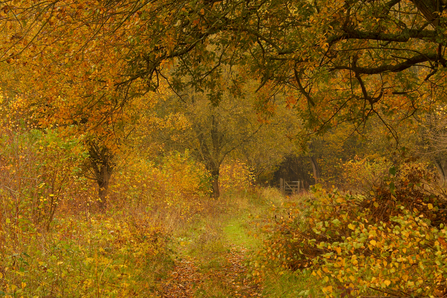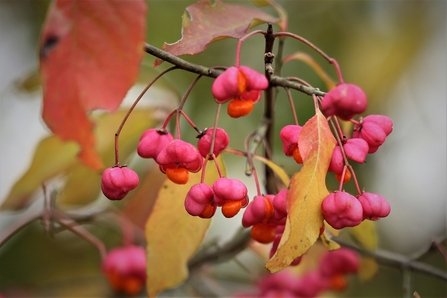
Fly agaric by Jon Hawkins
Turkeytail fungi by Ben Porter

Fly agaric by Jon Hawkins
October is the prime time of year to see fantastic fungi at BBOWT nature reserves, and the star of the show is quite possibly the fabulous fly agaric. This species produces the iconic toadstool of fairytale and legend with its glistening red cap and white freckles, usually found growing beneath birch, spruce and pine trees in woodland.
Find them at our Snelsmore Common reserve near Newbury, which is a treasure trove for mushrooms at this time of year.
See the best reserves for fungi
Please make sure you leave all fungi where you find them for others to enjoy. Fungi picking or foraging is not permitted on our nature reserves.
The colourful sight of fruiting green elf cup by Ali Mckernan
If you were to find a dead branch in the woods stained a beautiful turquoise colour, you can be certain to have found the striking green elf cup. Although the stained wood is a relatively frequent find, it's far less common to witness the fungus actually fruiting, so you should be particularly chuffed if these little cups also happen to be present! Keep a look out for these at Moor Copse, a tranquil woodland astride the River Pang in Berkshire.
The wood that this fungus infects, known as 'green oak' was highly prized by fine woodworkers in the 18th and 19th centuries, who used this to great effect in their intricate inlays for decorative wooden boxes.

Turkeytail fungi by Ben Porter
The turkeytail is a small, tough, bracket fungus that grows in tiered layers on dead wood - mainly beech or oak. It is very common and can be found throughout the UK on rotting stumps and branches.
It is distinguished from other brackets by its surprising range of colours, appearing in rainbow stripes and ranging from purples and reds to yellow and green, reminiscent of a turkey's tail.

Wood ear fungus sprouting out of a living tree. Picture: Pete Hughes
One of our most famous fungi, the wood ear's jelly-like lobes can be found sprouting out of dead logs and living branches in damp woodland. Also known as the jelly ear, it often emerges in tightly-coiled brains that inflate to their characteristic half-moon shape.
If you’re inspired by the range of forms and colours that fungi take, you can learn to capture them on canvas at our Art to Relax course on Wednesday 9 October at Windsor Great Park.

Warburg Nature Reserve, Autumn - Alison Lythgoe
As the month progresses, woodlands begin to turn all shades of gold, orange and bronze, and the ground becomes covered with a thick layer of fallen leaves.
Delve more into the science behind how and why leaves change colour in our blog, and use our handy ID chart below to identify which tree the fallen leaves have come from.
Woodland reserves including Bowdown Woods, Dancersend and Warburg Nature Reserve are renowned for their beautiful autumn colours. We'd love to see your photos of the colours of autumn, share them with us on X, Facebook and Instagram.
Redwing by Logan Walker
Redwing and fieldfare are thrushes that visit the UK in large numbers each winter from colder parts of northern Europe. The redwing has a mottled brown-and-white coat with distinctive orange patches under its wings, while the fieldfare has grey, black and chestnut plumage, with a strange chuckling call.
We see both each winter at our Wells Farm site in South Oxfordshire - a working farm run in harmony with wildlife. You can also look out for them at our regular bird walks at the Nature Discovery Centre in Thatcham, and if you’re in the mood for a hot drink as the days cool, then Birds and a Brew is the perfect autumn activity for you.

Ivy bees at Dry Sandford Pit by Peter Creed
A relatively new arrival to the UK, the ivy bee was first recorded here in 2001, and has now been found in much of Southern England and Wales, and in the Channel Islands. As suggested by its common name, ivy is the main source of pollen for this bee, a great reason to plant some in your garden! It is seen when ivy is in flower, from early September to early November, so October is the perfect time to look for them.
The ivy bee looks similar to the honey bee, but you can tell it apart by its orangey-brown hairy thorax, and the more distinct black-and-yellow stripes on its abdomen.

Spindle berries
Widespread in woodland edges and hedgerows, spindle is most striking in the autumn when its narrow, oval leaves turn reddish-orange and clusters of bright pink-and-orange berries hang from its twigs. Pay a visit to Dry Sandford Pit near Abingdon or Bacombe Hill near Wendover to enjoy its vibrant colours. The berries provide food for all kinds of creatures, including mice, birds and even red foxes, but are poisonous to us – so don’t be tempted!
Small Tortoiseshell ©Scott Petrek
While butterflies are a more common sight in spring and summer, peacock, red admiral and small tortoiseshell all overwinter as adults and can still be spotted at this time of year - but are thinking about hibernating. However, the small tortoiseshell is one of several species revealed to have suffered its worst year in the annual butterfly count.
Look out for them in the corners of sheds and houses trying to find a warm, safe spot, and if you find one, please don't put it outside!

Wild clematis or old man's beard. Photo by GanMed64/flickr.com
Wild clematis becomes more noticeable in the autumn thanks to the fluffy seed heads; hedgerows can be covered with this climber as it scrambles over shrubs.
Finches feed on the seed heads and many different species will use the fluffy seed heads for nesting material in the spring. The distinctive silky hairs on the seed heads give it its common name of 'old man’s beard'.